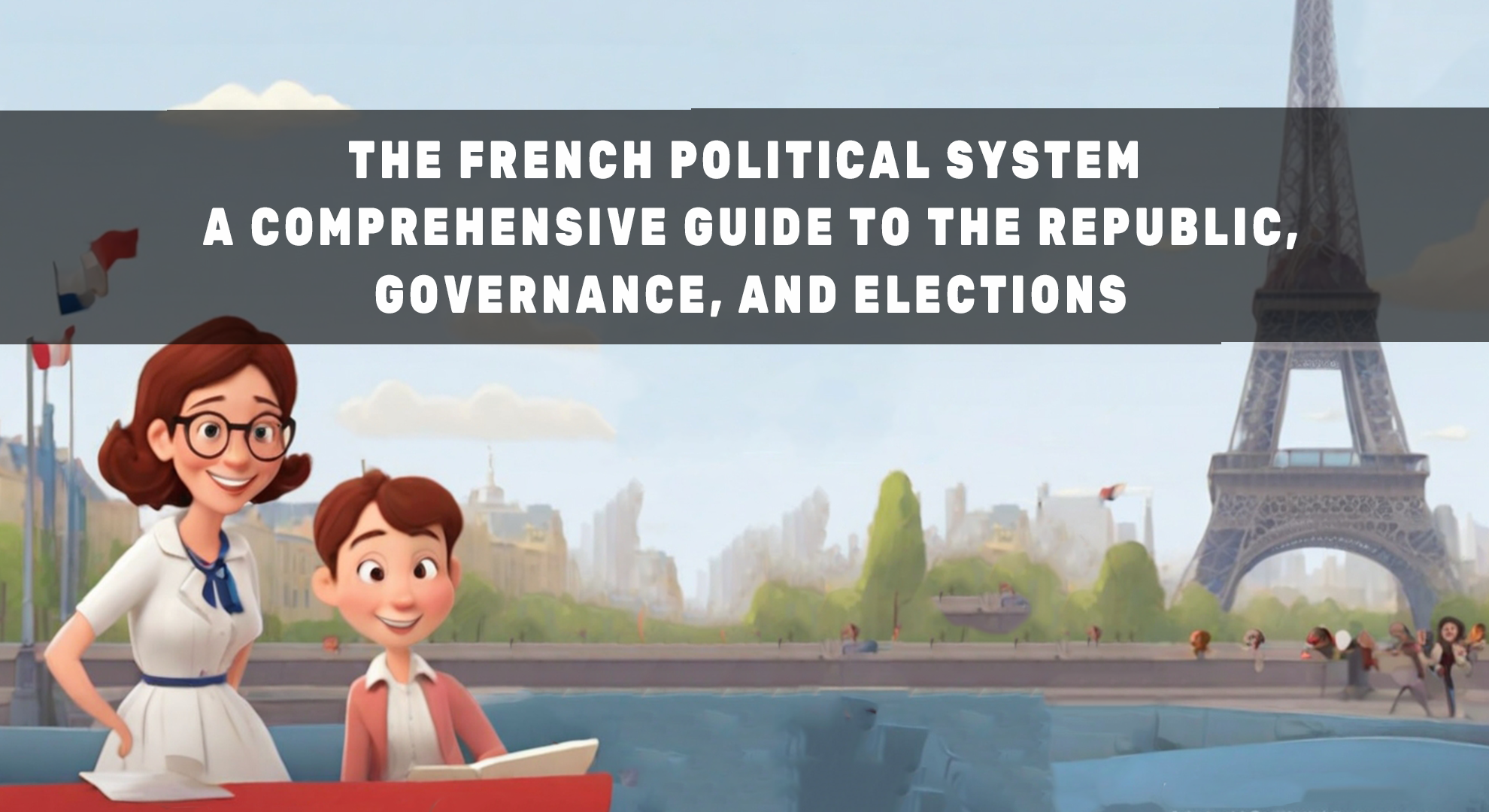Go on a journey through the intricacies of the French political landscape. This comprehensive guide aims to demystify the structures, principles, and processes that define the French Republic. From understanding the foundations of governance to navigating the complexities of elections, this lesson is your key to unlocking the secrets of the French political system.
Part 1: The French Republic
Welcome to the first leg of our journey into the heart of the French political system. In this section, we will unravel the rich tapestry of the French Republic, exploring its historical roots, fundamental principles, and the bedrock of its constitutional framework. Get ready to delve into the very essence of what defines France as a republic and understand the ideals that have shaped its political identity over centuries. Join us as we embark on a captivating exploration of the foundation of the French political landscape.
a. Historical Evolution: Explore the Historical Context and Birth of the French Republic
Venturing deeper into the annals of history, our exploration of the French Republic’s historical evolution takes us on a captivating journey through a tapestry woven with key events, revolutions, and constitutional milestones. It is a narrative that breathes life into the very essence of the Republic, where the echoes of transformative moments continue to reverberate through the corridors of time.
The saga commences with the thunderous echoes of the French Revolution, an epochal event that ignited the flames of change in the late 18th century. The storming of the Bastille in 1789 symbolized the uprising against the monarchy’s oppressive rule, heralding the birth of a revolutionary spirit that sought to dismantle the age-old structures of power. This seismic shift laid the groundwork for the birth of the First French Republic in 1792, marking a radical departure from centuries of monarchical rule.
As we traverse further, subsequent revolutions such as the July Revolution of 1830 and the February Revolution of 1848 punctuate the historical landscape. Each uprising, a chapter in the evolving narrative of France, contributed to the shaping of the republic’s identity. The call for liberty, equality, and fraternity echoed not just in the halls of power but resonated within the collective consciousness of the French people.
Constitutional developments emerged as guiding beacons illuminating the path toward a more inclusive and participatory form of governance. The establishment of the Second Republic in 1848, following the February Revolution, and the subsequent formation of the Third Republic after the fall of Napoleon III in 1870 showcased the adaptability and resilience ingrained in the French political spirit. These constitutional shifts were not mere legal adjustments; they reflected a society in constant flux, navigating the complexities of governance with a commitment to democratic ideals.
The intricate dance between republicanism and monarchy, the ebb and flow of constitutional structures, all played pivotal roles in molding the French Republic into a dynamic and evolving political entity. The struggle for political stability, the quest for representative governance, and the ongoing dialogue between tradition and progress became defining elements of the Republic’s historical evolution.
Our exploration transcends the mere recounting of events; it delves into the societal and cultural metamorphosis that accompanied these historical milestones. The French Republic, as we understand it today, is not a static entity frozen in time but a living testament to the enduring power of revolutionary ideals. The struggles, triumphs, and conflicts etched into the historical canvas form the very DNA of the French Republic, a beacon of resilience and a testament to the indomitable spirit of a nation in pursuit of a more just and equitable society.
Join us as we unravel the intricate layers of history, seeking not just the ‘how’ but the ‘why’ behind the establishment of the French Republic. In understanding this historical evolution, we gain insights into the core values that continue to shape the Republic and inspire nations worldwide.
b. Principles of the Republic:
In our exploration of the French Republic, we now turn our attention to the bedrock principles that form its very essence. At the core of the French political identity are three pillars that have stood the test of time and continue to shape the nation’s ethos: liberty, equality, and fraternity.
Liberty: Liberty, the first tenet, resonates as a beacon that guided the architects of the French Republic. It encapsulates the idea of individual freedoms and personal autonomy, emphasizing the right of every citizen to act in accordance with their will within the bounds of a just society. From the fervor of the French Revolution to the present day, liberty remains a rallying cry and a foundational value, shaping laws and policies that safeguard the rights of individuals.
Equality: Equality, the second principle, stands as a testament to the pursuit of a society where all individuals are treated with fairness and impartiality. The French Republic vehemently rejects any form of discrimination, advocating for the equal rights and opportunities of its citizens. This commitment to equality permeates various aspects of French life, from education to employment, fostering an environment where everyone is granted an equal chance to thrive.
Fraternity: Fraternity, the third pillar, embodies the spirit of brotherhood and solidarity among citizens. It goes beyond the individualistic pursuit of liberty and equality, emphasizing the interconnectedness of society. In the French Republic, fraternity signifies a collective responsibility to support one another, creating a sense of unity that transcends differences. This principle reinforces the idea that a harmonious and just society is built on the bonds of mutual support and shared citizenship.
Laïcité (Secularism): Beyond the triad of liberty, equality, and fraternity, the French Republic places great importance on laïcité, or secularism. This principle underscores the separation of religious institutions from the affairs of the state, ensuring a neutral and inclusive public sphere. Laïcité is a safeguard for individual freedom of conscience, promoting a society where diverse beliefs coexist while preventing any single faith from dominating public discourse. It reflects the commitment to maintaining a pluralistic and inclusive environment where citizens of various religious or non-religious backgrounds can participate equally in civic life.
In unraveling these principles, we gain a profound understanding of the values that have shaped the French Republic. Together, liberty, equality, fraternity, and laïcité form the bedrock upon which the nation’s institutions and identity stand. As we delve deeper into the intricacies of the French political ethos, these principles emerge as guiding lights that continue to illuminate the path of the Republic.
c. The French Constitution:
Our journey into the heart of the French political system takes us to the cornerstone of its governance—the French Constitution. A document of profound significance, it serves as the blueprint for the nation’s institutions, defining the roles, powers, and limitations that characterize the Republic.
Structure and Content: At the heart of the French Republic lies its constitution, a meticulously crafted document that encapsulates the ideals, values, and organizational structure of the nation. The French Constitution, as it stands today, emerged from a historical tapestry woven through revolutions, reforms, and societal evolution.
As we dissect its structure, we encounter a meticulous arrangement of articles and sections, each articulating a facet of the Republic’s governance. The preamble sets the tone, expressing the will of the French people to live together in liberty, equality, and fraternity. Following this preamble are chapters and articles that delineate the distribution of powers, the organization of the state, and the rights and duties of citizens.
Embedded within its content are the principles we explored earlier: liberty, equality, and fraternity. The constitution breathes life into these principles, enshrining them not as mere words but as the guiding ethos that directs the actions of the state and its citizens.
Constitutional Bodies: The French Constitution not only outlines the structural framework but also establishes key constitutional bodies entrusted with the implementation and protection of the Republic’s principles. These bodies, intricately woven into the constitutional fabric, act as guardians of the democratic ideals upon which the French Republic stands.
- The President of the Republic: At the apex of the executive branch sits the President, embodying the unity of the nation. Charged with safeguarding the Constitution, the President plays a pivotal role in foreign affairs, appointing the Prime Minister, and representing the Republic on the international stage.
- The Parliament: Comprising the National Assembly and the Senate, the French Parliament stands as the legislative powerhouse. It debates and enacts laws, scrutinizes the actions of the executive, and upholds the interests and aspirations of the French people. Through this bicameral structure, the Parliament ensures a thorough examination of legislation, embodying the democratic spirit.
- The Constitutional Council: As the guardian of constitutional legality, the Constitutional Council acts as a judicial check on legislation. It reviews the constitutionality of laws and safeguards the integrity of the democratic process. Composed of eminent jurists, the council ensures that the principles of the Republic remain inviolable.
As we navigate the intricate web of constitutional bodies, we witness a delicate balance of powers designed to prevent any one branch from dominating the others. The French Constitution, with its nuanced architecture, fosters a system where checks and balances prevail, ensuring the continued adherence to the principles that define the Republic.
Part 2: Governance in France
As we venture deeper into the intricate tapestry of the French political landscape, our focus shifts to the mechanisms that drive the Republic’s day-to-day operations. Part 2 unfolds the fascinating panorama of governance in France, where the executive, legislative, and judicial branches collaboratively shape the nation’s destiny. From the corridors of power to the chambers of legislation, join us in unraveling the dynamics that govern France and impact the lives of its citizens. This segment unveils the roles, responsibilities, and interactions of the various branches that collectively steer the ship of the French Republic through the currents of contemporary challenges and timeless principles.
a. Executive Branch:
In our exploration of the French political system, we now turn our gaze to the executive branch—an arena where decisions are forged, policies are shaped, and the vision of the nation comes to life. At the pinnacle of this branch stands the President of the Republic, a figure embodying the unity and leadership of France.
Powers and Responsibilities of the President: The President, seated at the apex of executive authority, shoulders the immense responsibility of steering the nation. Endowed with formidable powers, the President is the guardian of the Constitution, ensuring its faithful execution. From the solemn duty of representing France on the international stage to the critical role in appointing the Prime Minister, the President’s influence permeates every facet of the Republic’s governance.
One of the President’s paramount responsibilities is the formulation and implementation of foreign policy. As the chief diplomat, the President navigates the complex web of international relations, fostering alliances, addressing conflicts, and representing France’s interests with diplomatic finesse. This role not only shapes France’s global standing but also contributes to the stability and security of the broader international community.
Closer to home, the President plays a pivotal role in the domestic arena. While the day-to-day affairs may be overseen by the Prime Minister, the President wields significant powers in times of crises and extraordinary circumstances. From dissolving the National Assembly to appointing key government officials, the President’s authority ensures the smooth functioning of the Republic’s democratic machinery.
Role of the Prime Minister and the Cabinet: Nestled within the executive apparatus is the Prime Minister and the Cabinet, a collective body that collaborates to transform policies into tangible actions. The Prime Minister, appointed by the President, serves as the head of government, overseeing the executive decision-making process and coordinating the activities of government ministries.
The Cabinet, comprising ministers selected by the President on the recommendation of the Prime Minister, constitutes the nerve center of executive governance. Each minister presides over a specific portfolio, ranging from finance to foreign affairs, education to defense. Together, they form a cohesive unit tasked with translating the President’s vision into legislative proposals, administrative initiatives, and practical measures that impact the lives of citizens.
The relationship between the President and the Prime Minister reflects the delicate balance between executive authority and parliamentary democracy. While the President sets the overarching vision, the Prime Minister, as the head of government, translates that vision into concrete policies and actions. This collaboration, underscored by the collective responsibility of the Cabinet, ensures a dynamic and responsive executive branch that navigates the complexities of governance.
As we delve into the executive branch, we uncover not just a mechanism of governance but a dynamic interplay of leadership, decision-making, and the translation of vision into reality. The intricate dance between the President, Prime Minister, and the Cabinet forms a crucial chapter in the ongoing narrative of the French Republic’s governance, where the pursuit of liberty, equality, and fraternity finds its expression in the corridors of executive power.
b. Legislative Branch:
In the intricate machinery of the French political system, the legislative branch emerges as the crucible where policies are debated, laws are crafted, and the will of the people finds its expression. At the heart of this democratic discourse lies the bicameral structure of the French Parliament, a dynamic institution comprised of the National Assembly and the Senate.
Bicameral Nature of the French Parliament: The French Parliament, echoing the principles of representative democracy, operates on a bicameral model. This dual-chamber system is designed to provide checks and balances, ensuring that legislation undergoes thorough scrutiny before becoming law. The National Assembly, representing the people directly through elected deputies, serves as the lower chamber. In contrast, the Senate, with its composition of representatives from various constituencies, including local authorities, constitutes the upper chamber.
This bicameral structure reflects the nuanced approach to legislative decision-making in France. It acknowledges the diversity of perspectives and ensures that proposed laws undergo rigorous examination from multiple vantage points. The synergy between the National Assembly and the Senate contributes to the robustness of the legislative process, fostering a comprehensive and well-considered approach to lawmaking.
The Legislative Process: From Proposal to Enactment: The journey of a bill through the corridors of the French Parliament is a meticulous process that epitomizes the principles of democratic deliberation. It begins with the proposal of a bill, which can originate from the government, a member of parliament, or even the Senate. This initial step sets the legislative machinery in motion.
The bill is then subjected to detailed examination in committee sessions, where parliamentary members dissect its content, scrutinize its implications, and propose amendments. This thorough review process ensures that the proposed law aligns with constitutional principles and addresses the needs and concerns of the citizens it aims to govern.
Debates in both the National Assembly and the Senate further refine the bill, allowing for a robust exchange of ideas, perspectives, and potential amendments. This democratic dialogue serves as a crucible where the merits of the proposed law are evaluated, and its impact on society is thoroughly considered.
The final stage involves a vote in each chamber. For a bill to become law, it must garner majority support in both the National Assembly and the Senate. This requirement reinforces the collaborative nature of the legislative process, where consensus-building and compromise are essential elements.
Once a bill successfully navigates this legislative journey, it receives the presidential seal of approval, marking its transformation into law. This meticulous process, characterized by thoughtful debate, rigorous scrutiny, and democratic decision-making, exemplifies the commitment of the French Parliament to translating the will of the people into actionable legislation.
In delving into the bicameral nature of the French Parliament and the intricacies of the legislative process, we uncover not just a mechanism for lawmaking but a vibrant forum where the ideals of liberty, equality, and fraternity find their legislative embodiment. The chambers of the French Parliament stand as testament to the enduring commitment to democratic governance, where the voices of the people echo through the halls of legislative power.
c. Judicial System:
In the intricate tapestry of the French political landscape, the judicial system emerges as the bedrock of justice, ensuring the adherence to the rule of law and safeguarding the principles that define the Republic. The French judiciary, marked by its independence and commitment to impartiality, comprises key institutions, notably the Constitutional Council and the Court of Cassation.
The Constitutional Council: Upholding Constitutional Legality: At the apex of the French judicial system stands the Constitutional Council, a bastion of constitutional legality. Comprising eminent jurists and former political figures, the council acts as the guardian of the Constitution, ensuring that all laws passed conform to the fundamental principles enshrined in this foundational document.
The council plays a pivotal role in reviewing the constitutionality of laws before they come into effect. This proactive approach prevents laws that may infringe upon individual rights or contravene constitutional principles from being enacted. The Constitutional Council’s decisions serve as a cornerstone for the separation of powers, preventing any one branch of government from overstepping its constitutional bounds.
The Court of Cassation: The Highest Court of Appeal: Working in tandem with the Constitutional Council is the Court of Cassation, the highest court of appeal in the French judiciary. This court holds the crucial responsibility of ensuring the uniform interpretation of laws and the correct application of legal principles in lower courts.
The Court of Cassation does not reexamine the facts of a case but rather focuses on legal issues and the correct application of the law. Its judgments set legal precedents, guiding lower courts and fostering a cohesive and consistent legal framework. This role underscores the commitment to equal justice, where the application of the law is both fair and uniform across the nation.
Separation of Powers and the Judiciary’s Role: The French judicial system stands as a bulwark in upholding the separation of powers—a fundamental tenet of the Republic. The independence of the judiciary ensures that it remains free from undue influence, enabling it to act as a check on the executive and legislative branches. This separation of powers is a cornerstone of the French political system, preventing the concentration of authority in any single branch and fostering a system where each branch operates within its defined sphere.
The judiciary’s role extends beyond interpreting and applying the law. It serves as a protector of individual rights, a defender of constitutional principles, and a guardian of the democratic ethos. The judiciary’s commitment to upholding the rule of law ensures that justice is blind, impartial, and accessible to all citizens, regardless of their status or background.
As we navigate the intricate contours of the French judicial system, we encounter not just legal institutions but guardians of justice, tasked with preserving the integrity of the Republic. The Constitutional Council and the Court of Cassation, through their unwavering commitment to constitutional legality and the uniform application of the law, stand as pillars that support the ideals of liberty, equality, and fraternity in the pursuit of justice in the French Republic.
Part 3: Elections in France
As we delve into the intricate fabric of the French political system, our exploration brings us to the pulsating heart of democratic expression—elections. Part 3 unfurls the dynamic landscape of electoral processes in France, where the voice of the people resonates through ballots, shaping the composition of representative bodies and influencing the direction of the Republic. From presidential races that capture the nation’s attention to local elections that reflect the diverse aspirations of communities, join us on this journey through the electoral tapestry of France. In this segment, we unravel the intricacies of the electoral process, the significance of different elections, and the vital role they play in sculpting the democratic tableau of the French Republic.
a. Electoral System:
Within the vibrant spectrum of French democracy lies an intricate electoral system, a complex yet finely tuned mechanism that orchestrates the expression of the people’s will. This system, marked by its nuanced features, encompasses elements such as proportional representation and the distinctive two-round voting process, each contributing to the distinctive character of French political representation.
Proportional Representation: A Mosaic of Voices:
At the heart of the French electoral landscape is the principle of proportional representation, a mechanism designed to ensure a fair and equitable distribution of seats among competing political parties. This approach allows voters to cast their ballots for a party, rather than an individual candidate, and the allocation of seats in legislative bodies corresponds proportionally to the overall vote share each party secures.
Proportional representation fosters a diverse political landscape, giving voice to a multitude of perspectives within the elected assembly. This mosaic of voices enriches the democratic discourse, reflecting the varied aspirations, ideologies, and concerns of the electorate. The proportional representation system plays a pivotal role in shaping the composition of the National Assembly, the lower house of the French Parliament, where the diversity of political thought finds its legislative expression.
Two-Round Voting: A Mechanism of Democratic Refinement:
Complementing the proportional representation model is the distinctive two-round voting system, a hallmark of French elections. In this method, if no candidate secures an absolute majority (50% plus one vote) in the first round, a second round is conducted, pitting the top two candidates against each other. This ensures that the ultimate victor enjoys broad-based support, having surpassed a significant threshold of approval.
The two-round voting system introduces an element of strategic decision-making for voters and political parties alike. It encourages candidates to appeal to a broad spectrum of voters in the first round, fostering inclusivity and coalition-building. Simultaneously, it provides voters with an opportunity to reassess their choices in the second round, contributing to the election of candidates with broader appeal and consensus.
Shaping Political Representation at Different Levels:
The French electoral system operates as a dynamic force, molding political representation at various levels of governance. From municipal councils to the National Assembly, the interplay of proportional representation and two-round voting constructs a diverse and responsive political landscape.
At the local level, municipal and regional elections embody the principles of proximity and community representation. The electoral system facilitates the election of officials who intimately understand the unique needs and dynamics of their constituencies, fostering a connection between citizens and their elected representatives.
In the realm of national governance, the National Assembly reflects the intricate weave of political ideologies and public sentiment. Proportional representation ensures that a spectrum of voices finds expression, contributing to the formulation of laws and policies that resonate with the diverse fabric of French society.
b. Presidential Elections:
In the grand theater of French democracy, presidential elections stand as the apex, capturing the collective imagination and shaping the destiny of the Republic. This unique electoral spectacle, distinguished by its two-round system, unfolds as a drama that engages the entire nation in a journey of political deliberation and choice.
The Two-Round System: A Crucible of Democratic Decision-Making:
At the core of French presidential elections is the distinctive two-round voting system. This nuanced mechanism ensures that the elected president commands not just a plurality but an absolute majority of the votes—a resounding mandate from the people. In the first round, a diverse array of candidates presents their visions for the future, vying for the support of the electorate. If no candidate secures an outright majority, the top two contenders proceed to a second round, where the final verdict is rendered.
The two-round system adds a layer of complexity and strategic calculation to the electoral landscape. In the first round, candidates must appeal broadly to a spectrum of voters, recognizing the need for broad-based support. The second round, a head-to-head contest, demands candidates to consolidate their appeal and present themselves as the candidate best positioned to lead the nation.
Campaign Process: A Tapestry of Political Narratives:
The canvas of a French presidential campaign is painted with the vibrant hues of political narratives, policy proposals, and aspirational visions for the future. From the grandeur of large-scale rallies to the intimacy of town hall meetings, candidates traverse the nation, engaging with citizens, addressing concerns, and articulating their vision for the Republic.
The campaign process is not merely a series of events; it is a dynamic exchange between candidates and voters, where ideas are scrutinized, promises are weighed, and the character of leadership is evaluated. The electorate becomes an active participant in the democratic narrative, influencing the trajectory of the campaign through rallies, debates, and, ultimately, the ballot box.
Key Presidential Debates: The Crucible of Political Dialogue:
Central to the presidential campaign are the pivotal debates, where candidates confront each other on a public stage, presenting their perspectives, defending their policies, and, in the process, showcasing their leadership acumen. These debates serve as a crucible of political dialogue, providing voters with a firsthand look at the candidates’ capabilities, convictions, and readiness to lead.
The significance of key presidential debates goes beyond the immediate spectacle. They are moments of democratic reckoning, where the nation collectively assesses the contenders and their capacity to address the pressing challenges facing the Republic. The debates offer a platform for candidates to articulate their positions, respond to critiques, and engage in a dialogue that elucidates their vision for the nation.
In the grand tapestry of French presidential elections, the two-round system, the vibrant campaign process, and the pivotal debates converge to create a democratic spectacle that resonates with the principles of liberty, equality, and fraternity. The electorate, armed with the power of choice, plays a decisive role in shaping the future of the Republic, underscoring the significance of presidential elections as a cornerstone of French democracy.
c. Parliamentary Elections:
In the intricate dance of French democracy, parliamentary elections emerge as a pivotal chapter, determining the composition of the National Assembly and influencing the legislative direction of the Republic. As we navigate the dynamics of these elections, we unravel the intricate interplay of political forces, the role of political parties, and the art of coalition-building that collectively shapes the contours of governance.
Dynamics of Parliamentary Elections: A Democratic Canvas Unfolding:
Parliamentary elections in France represent a canvas upon which the democratic aspirations of the nation are painted. The electorate, armed with the power to shape the legislative landscape, engages in a thoughtful exercise of choice. Unlike the singular focus of presidential elections, parliamentary contests involve the selection of representatives for each constituency, contributing to the mosaic of voices that echo within the hallowed halls of the National Assembly.
The dynamics of these elections are influenced by the principles of proportional representation, where political parties vie for a share of seats corresponding to their overall vote share. This nuanced approach fosters a diverse and representative legislative body, reflecting the varied perspectives, ideologies, and concerns of the electorate.
Role of Political Parties: Architects of Legislative Narratives:
At the heart of parliamentary elections are the political parties, each functioning as an architect of a unique legislative narrative. These parties serve as vessels for the articulation of ideologies, policy proposals, and visions for the future. Candidates, aligned with party platforms, become conduits through which the electorate expresses its collective will.
The spectrum of political parties spans a wide array of ideologies, from the left to the right, and encompasses diverse policy stances on issues ranging from economic governance to social justice. This multiplicity ensures that the National Assembly becomes a microcosm of the nation’s political diversity, fostering robust debates and legislative deliberation.
Coalition-Building: Forging Alliances for Governance:
In the aftermath of parliamentary elections, the process of coalition-building comes to the fore—a delicate art of political negotiation and consensus-building. Given the proportional representation model, it is rare for a single party to secure an absolute majority in the National Assembly. Hence, parties must engage in coalition-building to form a government that can command the necessary support for legislative initiatives.
Coalition-building involves negotiations between parties, where shared priorities, policy alignment, and governance principles become the focal points of discussion. The outcome of these negotiations determines the composition of the government, with parties joining forces to create a collaborative and functional executive.
This process of coalition-building adds a layer of complexity to the parliamentary landscape, requiring political actors to navigate the terrain of compromise and consensus. It underscores the necessity of cooperative governance, where diverse voices come together to address the challenges facing the Republic.
In the intricate dance of parliamentary elections, the role of political parties and the delicate art of coalition-building shape the trajectory of legislative representation. The National Assembly, born out of the democratic will of the people, becomes a crucible where the principles of liberty, equality, and fraternity find legislative expression, defining the course of governance in the French Republic.
Conclusion:
In our exploration of the intricate facets of the French political system, we have embarked on a journey through the heart of democracy, where principles of liberty, equality, and fraternity resonate in every electoral process and legislative deliberation. From the unique features of the French electoral system to the grandeur of presidential and parliamentary elections, each element contributes to the vibrant tapestry of French governance.
Presidential elections stand as captivating spectacles, where the two-round system adds layers of complexity to the democratic narrative. Candidates traverse the nation, engaging in a political dialogue that culminates in key debates, offering the electorate an intimate glimpse into their visions for the Republic.
Parliamentary elections, characterized by proportional representation, bring forth a diverse array of political parties, each weaving its narrative into the intricate legislative fabric. The role of these parties extends beyond electoral contests; they become architects of governance, engaging in the delicate dance of coalition-building to shape the executive and the policies that govern the nation.
As we delve into the mechanisms of the executive, legislative, and judicial branches, we uncover not just structures of power but guardians of justice, where the Constitutional Council and the Court of Cassation stand sentinel, upholding the rule of law and ensuring the separation of powers.
Elections, debates, and governance are not merely processes; they are the expressions of a dynamic democracy where the voice of the people echoes in the chambers of power. The commitment to democratic ideals resonates not only in the grandeur of presidential campaigns or the intricacies of legislative processes but also in the daily interactions between citizens and their representatives.
In navigating the seas of French governance, we find a commitment to democratic values that transcends individual elections or legislative sessions. It is a commitment woven into the very fabric of the Republic, shaping its destiny and ensuring that the principles of liberty, equality, and fraternity endure as guiding stars in the ongoing journey of French democracy. The intricate dance of elections, governance, and justice becomes a testament to the resilience of democratic ideals, reminding us that the pursuit of a more just, equal, and free society is a perpetual voyage, guided by the enduring spirit of the French Republic.


















